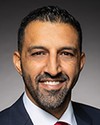If you're talking strictly from a communications standpoint, first of all, no.
Having passengers stranded on a train for as long as they were is not acceptable. In terms of how we go about improving our performance going forward—you're asking specifically on communications—as I said and like Hoang said, we want to make sure that there's one point of contact so that we avoid multiple messages and creating chaos where there should be clarity. I'm not saying there was, but there is an opportunity to do this better, and that's what we're focused on.
We did communicate, but, as I said, it was an evolving situation, so our message evolved as well. There's no doubt that, as I said, we are looking for opportunities to make sure that the message is streamlined, that there's one point of communication going forward when that happens.




